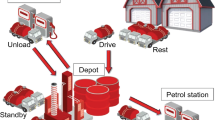Abstract
This paper addresses a real-life multi-compartment tank-truck loading problem for fuel distribution. The proposed loading problem incorporates two safety considerations that enhance the balance of the load: i) the maximum axle weight restrictions, and ii) safety loading rules for mitigating the effects from en-route fuel oscillation. Given a route for delivering a set of orders for fuel, the proposed Truck Loading Problem aims to assign the orders to the compartments of a truck under the following load balance restrictions: i) the weight borne by each axle must not exceed certain limits at any stage of the distribution route, and ii) each compartment should be loaded either below 20% or over 80% of its capacity to mitigate fuel oscillation effects. A balanced loading of the orders at the depot does not guarantee that the load will be balanced in all subsequent segments of the delivery route. Therefore, both safety constraints must be checked in every route segment. Two MILP models are developed for the proposed loading problem covering the cases in which the compartments of the truck are equipped or not with flow meters. A major novel feature of the proposed work pertains to the development of a computational method for estimating the load weight distribution over each axle of a rigid truck with more than two axles. A series of computational experiments were performed for exploring the impact of both types of constraints on loading and route efficiency. A major finding is that using a marginal loading flexibility (i.e., deviation of the ordered quantity from the quantity delivered) diminishes any effect of the two constraints on loading efficiency.





Similar content being viewed by others
Availability of data and material
Not applicable.
Code availability
Not applicable.
References
Abdel-halim NA (2015) Reflection of truck loads distribution methods on the truck wheels reaction forces. Am J Eng Technol Soc 2(4):67–76
Alonso MT, Alvarez-Valdes R, Iori M, Parreño F, Tamarit JM (2016) Algorithms for pallet building and truck loading in an inter depot transportation problem. Math Probl Eng 2016(8):1–11. https://doi.org/10.1155/2016/3264214
Bedenik BS, Besant CB (1999) The displacement method. Analys Eng Structur. https://doi.org/10.1533/9780857099723.242
Cornillier F, Boctor FF, Laporte G, Renaud J (2008a) A heuristic for the multi-period petrol station replenishment problem. Eur J Oper Res 191(2):295–305. https://doi.org/10.1016/j.ejor.2007.08.016
Cornillier F, Boctor FF, Laporte G, Renaud J (2008b) An exact algorithm for the petrol station replenishment problem. J Operational Res Soc 59(5):607–615. https://doi.org/10.1057/palgrave.jors.2602374
Cornillier F, Laporte G, Boctor FF, Renaud J (2009) The petrol station replenishment problem with time windows. Comput Oper Res 36(3):919–935. https://doi.org/10.1016/j.cor.2007.11.007
Davies AP, Bischoff EE (1999) Weight distribution considerations in container loading. Eur J Oper Res 114(3):509–527
DOT US (2018) Large truck and bus crash facts 2018. Analysis division federal motor carrier safety administration. Crashes Table 1. Fatal Crashes Involving Large Trucks by First Harmful Event, 2016–2018
Gehring H, Bortfeldt A (1997) A genetic algorithm for solving the container loading problem. Int Trans Oper Res 4(5–6):401–418. https://doi.org/10.1016/S0969-6016(97)00033-6
Hvattum LM, Fagerholt K, Armentano VA (2009) Tank allocation problems in maritime bulk shipping. Comput Oper Res 36(11):3051–3060. https://doi.org/10.1016/j.cor.2009.02.002
Jacob B, Beaumelle VF (2010) Improving truck safety: potential of weigh-in-motion technology. IATSS Research 34(1):9–15. https://doi.org/10.1016/j.iatssr.2010.06.003
Lahyani R, Coelho LC, Khemakhem M, Laporte G, Semet F (2015) A multi-compartment vehicle routing problem arising in the collection of olive oil in Tunisia. Omega 51:1–10. https://doi.org/10.1016/j.omega.2014.08.007
Lim A, Ma H, Qiu C, Zhu W (2013) The single container loading problem with axle weight constraints. Int J Prod Econ 144(1):358–369. https://doi.org/10.1016/j.ijpe.2013.03.001
Limbourg S, Schyns M, Laporte G (2012) Automatic aircraft cargo load planning. J Oper Res Soc 63(9):1271–1283. https://doi.org/10.1057/jors.2011.134
Liu F-H, Hsiao C-J (1997) A three-dimensional pallet loading method for single-size boxes. J Operational Res Soc 48(7):726–735. https://doi.org/10.1057/palgrave.jors.2600426
Mongeau M, Bes C (2003) Optimization of aircraft container loading. IEEE Trans Aerosp Electron Syst 39(1):140–150. https://doi.org/10.1109/TAES.2003.1188899
Novas JM, Ramello JI, Rodríguez MA (2020) Generalized disjunctive programming models for the truck loading problem: a case study from the non-alcoholic beverages industry. Transport Res Part E: Logistics Trans Rev 140:1–28. https://doi.org/10.1016/j.tre.2020.101971
Øvstebø BO, Hvattum LM, Fagerholt KF (2011) Routing and scheduling of RoRo ships with stowage constraints. Transport Res Part C: Emerg Technol 19(6):1225–1242. https://doi.org/10.1016/j.trc.2011.02.001
Pollaris H, Braekers K, Caris A, Janssens GK, Limbourg S (2014) Capacitated vehicle routing problem with sequence-based pallet loading and axle weight constraints. EURO J Transport Logistics 5(2):231–255. https://doi.org/10.1007/s13676-014-0064-2
Pollaris H, Braekers K, Caris A, Janssens G K, & Limbourg S (2013) The capacitated vehicle routing problem with loading constraints. 15th International conference on Harbour, maritime & multimodal logistics modelling and simulation, 7–12.
Province of Nova Scotia (2020). Weights and dimensions of vehicles regulations. Royal Gazette Part II, N.S. Reg. 32/2020. https://novascotia.ca/just/regulations/regs/mvwd.htm
Ramos AG, Silva E, Oliveira JF (2018) A new load balance methodology for container loading problem in road transportation. Eur J Oper Res 266(3):1140–1152. https://doi.org/10.1016/j.ejor.2017.10.050
Vancroonenburg W, Verstichel J, Tavernier K, Vanden Berghe G (2014) Automatic air cargo selection and weight balancing: a mixed integer programming approach. Transport Res Part E: Logistics Transport Rev 65(1):70–83. https://doi.org/10.1016/j.tre.2013.12.013
Wang L, Kinable J, van Woensel T (2020) The fuel replenishment problem: a split-delivery multi-compartment vehicle routing problem with multiple trips. Comput Oper Res 118:1–16. https://doi.org/10.1016/j.cor.2020.104904
Wheeler J B (1876) An elementary course of civil engineering for the use of cadets of the united states military academy.
Yuceer U (1997) A multi-product loading problem: a model and solution method. Eur J Oper Res 101(3):519–531. https://doi.org/10.1016/S0377-2217(96)00185-3
Funding
Partial financial support was received from the Research Center of the Athens University of Economics and Business (AUEB-RC) through projects ΕΡ-3002–01 and ΕΡ-3108–01 and from the State Scholarship Foundation through the Doctorate Scholarship Program MIS 5000432 (2014–2020).
Author information
Authors and Affiliations
Corresponding author
Ethics declarations
Conflicts of interest
Not applicable.
Additional information
Publisher's Note
Springer Nature remains neutral with regard to jurisdictional claims in published maps and institutional affiliations.
Supplementary Information
Below is the link to the electronic supplementary material.
Rights and permissions
Springer Nature or its licensor holds exclusive rights to this article under a publishing agreement with the author(s) or other rightsholder(s); author self-archiving of the accepted manuscript version of this article is solely governed by the terms of such publishing agreement and applicable law.
About this article
Cite this article
Androutsopoulos, K.N., Karouti, E. A safety-driven truck loading problem. Oper Res Int J 22, 4931–4963 (2022). https://doi.org/10.1007/s12351-022-00737-7
Received:
Revised:
Accepted:
Published:
Issue Date:
DOI: https://doi.org/10.1007/s12351-022-00737-7




